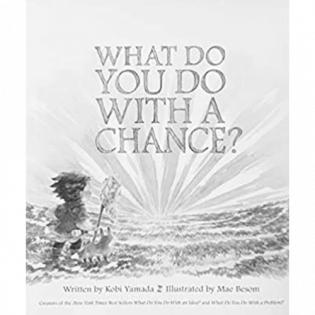What Do You Do with a Chance? Literature Guide
- A child who is unsure about what to do with a new experience learns to cultivate courage, curiosity, and a willingness to try new things. Reading this at any age provides an opportunity to discuss a "growth mindset," which means to be open to new experiences and take risks rather than be limited to what is safe or familiar. The book also calls attention to times we let fears and what other people think get in our way of doing the right thing. What can we do to help others take their chance?
Literature Guide by Maureen Klein
Before Reading
Ask: The title itself is a question. Talk about a possible answer to the question before reading. Use clues from the cover picture. Discuss the meaning of "a chance."
Show: The author and illustrator work closely together to communicate their message to the reader. Show the first two pages of the story and talk about the colors used. Look closely while reading at what the pictures show that isn't in the text.
Connect: Pay attention to the use of color throughout and connect it to how the main character feels in the beginning and throughout the story.
During Reading
Connect: Pause at the page that begins, “I went to reach for it, but I missed and fell.” Discuss when listeners have experienced that feeling. Share a time you tried something and it didn’t work out.
Ask: What are some things that make us want to give up?
Show: Look at the details on the page that begins, “Then I thought, ‘Maybe I don’t have to be brave all the time.'” Say, “Our main character felt foolish and embarrassed when he fell. How does he feel now?” Ask listeners to give evidence from the pictures and text to support their answer.
After Reading
Ask: How would you describe how the main character changed throughout the book? If needed, specifically prompt listeners to point out evidence in the text and images of a change in the character’s feelings.
Show: Look at the text that describes what a chance can become. Talk about what chances they may encounter and expand the list of ideas. Include ideas that help others or show caring.
Connect: What do YOU do with a chance? How can you help others see their chances and be brave? How does listening to others help them take chances?
Activities
- Make a list of ten things that you would like to do. Think of things you’d like to try or experience or learn that might be difficult for you to achieve. Pick one of them and make a step-by-step plan to do it, including the steps that require more information or resources or help from others.
- Taking chances helps you be your best self. Draw your best self, including what you hope for yourself.
- Talk about what you do when you see someone taking a risk and they fall down. What are ways to encourage people? What are ways to stop people who laugh when others fall?
- There are so many wonderful picture books with themes of courage and growth mindsets. Read some of these titles:
- What do you do with a Problem? by Kobi Yamada
- What do you do with an Idea? by Kobi Yamada
- Brave Irene by William Steig
- Tomorrow I’ll be Brave by Hische
